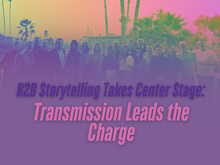Going BIG on Entertainment. Do brands need a different approach to upper funnel reach?
- Jordan Kelley
- Mar 30, 2023
- 4 min read
Al Berry, Fellow at Royal Society of Arts
Want weekly exclusive brand storytelling content like this direct to your inbox? Subscribe to the Brand Storytelling Newsletter.
With AB InBev launching an entertainment division should other brands look to bigger entertainment plays to reach consumers?
It’s almost 10 years to the day since picking up the BAFTA for best British short film. A day I’ll never forget. Room 8, a film conceived, developed and paid for by a brand. The Bombay Sapphire Imagination series was light years ahead of its time and represented a seminal moment in branded entertainment. Could it finally be that brand-created films could compete critically and creatively with their puritan cousins?
The need to reach new discerning audiences, the ones who ad-block and get their fix of entertainment from streaming services is more prevalent than ever and not one lost on Cannes Creative Marketeer of the Year 2022 and the Super Bowl biggest advertiser, AB InBev.
Today, they launched an Entertainment division as part of their internal agency. DraftLine Entertainment has a remit to develop and produce films, TV shows to sell to steamers and distributors. By enlisting some creative muscle from the likes of Oscar-winning producer Michael Sugar and brand storytelling veteran Jae Goodman, who set up Nike’s Waffle Arm Entertainment, they have every chance of success.
The desire to be part of the action not just part of the ad break is not new, but that requires a brand to readjust its perspectives. Creating advertising is very different from creating entertainment and if the ad men are left in charge, then that’s when the wheels quickly come off. Being entertaining not interruptive are two different states of mind and require very different approaches. Having the right experience at the helm is crucial.
The media landscape has evolved significantly in the last ten years and with it how brands can engage with consumers has followed suit. For every stand out piece of branded entertainment, ten more never go beyond a boring documentary or a contrived elongated product placement. Look no further than the Birra Moretti “three-part content series” on Amazon. No one has actually dared refer to it as entertainment unless entertainment is the sound of the agency and client arguing ‘to get more product shots in’. I can’t help that feel somewhere in there was an idea as free-flowing as Travels with My Father, that got killed by the brand.
So where to next?
I’ve always believed that success for brands lies in creating large-scale brand-owned IP that can then be exploited. If you’re going to do something in the entertainment space, do just that.
Create a piece of entertainment that can stand up critically and be the best version of itself. Tell the brand police to look away and concentrate on activating the film in other channels. Marvel Inc. creates brilliant films and then manages to shift millions of pounds worth of products off the back of the IP it’s created. Be more Marvel!
Entertainment first. Remember why the audience is watching- to be entertained, to escape, not to be sold to. Your far more likely to start a conversation around the water cooler tomorrow about the show, if you follow this approach.
If this recollection and feeling of enjoyment of watching can the be triggered again as part of the customer journey then its a win. On pack, in social, in digital, at checkout, develop your entertainment as part of an integrated campaign, not some stand-alone vanity project that becomes difficult to measure. Hollywood spends millions on promoting films as do all the streamers. Be prepared to promote it- properly!
This mantra was at the forefront of the thinking when I relaunched Supermarket Sweep to a new audience ITV, with new teeth and Tesco at the helm. Subsequently, the results commercially and critically were outstanding, by tapping into the ‘entertainment time’ of a customer proved a win for both broadcasters and brand.
Creating entertainment is hard. Show business is hard and requires a different set of skills to one’s you probably have at your disposal within your current brand team.
Don’t convince yourself that just because you’re a brand and fronting some production cash you're going to walk into Apple or Netflix and they are going to want to bite your arm off for your remake of "Cheers bought to you by Budweiser". (Although for the record that would be awesome - I’m all about breathing life into old formats!).
Don’t forget the business side of it. You’re creating revenue-generating entertainment, not a marketing expense. Ask yourself if there wasn’t a brand involved would people still buy it, watch it and talk about it.
To get this right requires a fresh approach, healthy budgets and a dedicated team of experts. It’s exciting to see that with AB InBev is taking a grown approach, dedicating resources and placing Lauren Denowitz as a Studio Head, rather than letting this sit with existing marketing teams.
To quote Denowitz let’s see how this plays out and “what lies at the intersection of beer x culture x storytelling”. This could be worth watching.

Cheers.
Executive Strategy & Innovation Director | Marketing Leader building the next generation of sustainable brands | Fellow (FRSA) at Royal Society of Arts.

























